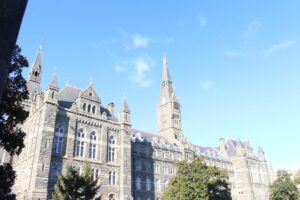This article is part of a series of explainer pieces by the Voice on some of the most important topics on campus. Other articles in the series can be found here.
Operating Georgetown University is a $1.5 billion undertaking each year.
Though the university’s exact budget changes year to year, and certainly will look different for the foreseeable future due to substantial financial losses and cost-saving measures taken in response to COVID-19, the 2019 fiscal year (from July 2018 through June 2019) information, which is the most recent available, sheds light on the financial operations of the university before the pandemic, including the salaries of some of its highest-paid employees.
Because it is a not-for-profit university, Georgetown is required to file a Form 990 each year detailing its revenue and expenses. These filings are required to be furnished by the university upon request. A complete copy of the 2018 filing can be found here.
Top numbers over time
Georgetown’s yearly revenue has increased fairly steadily over the past decade, from just over $1.1 billion in 2010 to $1.7 billion in 2019, which is faster than would be predicted by inflation rates.
Program services, which include tuition and most revenue that comes from students, make up the majority of the university’s revenue each year, with its share hovering just around 60 percent, or about $1 billion. The next largest category by far is contributions, including grants and donations made to the university. Though in some years, contributions have constituted nearly 30 percent of revenue, in 2019 they only comprised 22 percent, about $382 million. This category also includes government grants. The remaining revenue comes mainly from income made on the university’s investments, the sale of any assets, and a few smaller categories.
Similarly, expenses have increased over the years, from $1 billion in 2010 to $1.5 billion in 2019 (again, faster than inflation). Most expense categories are smaller than revenue categories, with the largest—salaries, wages, and benefits—making up about half of all expenses. The other main category of note, grants paid by the university for research and other endeavors, incurred $250 million of expenses.
The difference between these categories, Georgetown’s net revenue, totals to between $100 million and $200 million each year. In 2019, the net revenue was just over $150 million. This money, once adjusted per financial rules, is usually added to the university’s assets as cash or investments. Because Georgetown is a non-profit, they cannot keep it as profit.
Though not as steadily, Georgetown’s net assets (total assets minus liabilities owed to others), have increased as well, totaling $1.7 billion in 2019. These assets do include cash and easily accessible savings, but the vast majority are investments from the endowment and physical assets (land and buildings).
In FY 2019, the university’s endowment totaled $1,822,484,263. This makes Georgetown the sixtieth richest university by endowment, approximately. The endowment itself is not one large fund, but several smaller sub-funds invested in different locations (the details of this are not publicly available).
Seventy percent of this $1.8 billion is the permanent endowment, which cannot be spent on anything and exists to generate spendable interest to be used for purposes specified by the donor. Eight percent is partially restricted, meaning the income from the gift must be used for a specific purpose for a period of time or until a certain event occurs. Twenty-one percent is quasi-endowment that is board-designated, which could potentially be liquidated (pulled out of investments and turned into cash) and used at the discretion of Georgetown’s Board of Directors. Restrictions on endowments are not uncommon; a 2019 study from the Council for Advancement and Support of Education found 95 percent of gifts to university endowment funds are restricted for specific purposes.
The investment of the endowment has received attention from students in past years. Following years of activism from GU Fossil Free, Georgetown announced in 2020 the university would divest all funds from the fossil fuel industry within ten years. In the summer of 2020, a campaign began to divest the university from prisons.
Many students have also called for Georgetown, and other schools, to dip into their endowments to cover student costs incurred by COVID-19. Though the university has not made a statement on this, it seems only the board-designated portion of the endowment could be touched, and it is unclear how much could actually be liquidated or how long that process would take. It is also worth noting three categories in the endowment are all designed to generate interest when they remain invested, which is why it is rare for universities to touch endowments.
The university holds $71,515,820 in land assets (primarily campuses) and $913,721,971 in building assets. They also hold $1,296,224,718 from the endowment, in “alternative investments,” which refers to non-traditional investments (not stocks, bonds, or cash).
Salaries and contracts
Georgetown employed just over 15,000 employees in FY 2019. As part of the filing process, Georgetown is required to provide the salaries of stakeholders and certain key or highest-paid employees.
University President John DeGioia received $1.1 million in compensation from the university for the 2019 fiscal year, making him the latest to join the ranks of university presidents making over one million dollars.
The 2019 filing includes compensation information for other key employees, such as Provost Robert Groves ($689,359), Chief Operating Officer Geoff Chatas ($799,226), Vice President for Finance David Rubenstein ($453,678), Vice President and General Counsel Lisa Brown ($494,222), Vice President for Research and Chief Technology Officer Spiros Dimolitsas ($625,456), Vice President and Chief of Staff Joseph Ferrara ($405,936), Executive Vice President for Health Sciences Edward Healton ($769,776), Vice President for Diversity and Equity Rosemary Kilkenny ($346,541), Vice President for Advancement R. Bartley Moore ($500,070), Vice President for Public Affairs Erik Smulson ($302,370), and Executive Vice President for the Law Center William Treanor ($569,572).
The three highest-paid employees that year aside from key employees were Georgetown men’s basketball head coach Patrick Ewing ($3,142,943), Chief Investment Officer Micheal Barry ($936,582), and Director of the Lombardi Cancer Center Louis Weiner ($734,049). The highest-paid professor is in the McDonough School of Business, Reena Aggarwal ($712,764), and the next highest-paid administrator is the dean of the Qatar campus Ahmad Dallal ($708,462).
1,552 employees, representing ten percent of the total number, make over $100,000 each year. Any employee not listed above makes less than Dallal, as his salary was the lowest of the five highest-paid non-key employees the university was mandated to report.
The university also pays a significant amount of money to contractors, including Aramark, which handles dining services ($26,134,459), MedStar Hospital ($24,711,332), 2U, an educational technology company ($15,331,853), and $10 million to construction companies.
Financial planning (ahead)
On May 12, DeGioia announced the university was expected to see a $50 million budget shortfall by August. The updated Fall 2020 plan, which includes a very small number of students living on campus and thus paying for room and board, is likely to increase this shortfall over the coming semester. Georgetown has also promised all students a 10 percent tuition discount in light of all classes going virtual. The shift to virtual academics will likely lead to a drop in enrollment for the upcoming academic year, further decreasing tuition revenue.
Due to the shortfall, the university is currently in a hiring and raise freeze and is suspending contributions to staff retirement funds through the 2021 fiscal year. Senior leaders, including those whose salaries are included above, have taken voluntary pay cuts totaling $2.4 million.
The combination of all these new measures means university financial statements will look very different in the coming years, as Georgetown responds to the new costs and challenges brought by the pandemic. The Voice will cover changes impacting the university community as they are announced.




